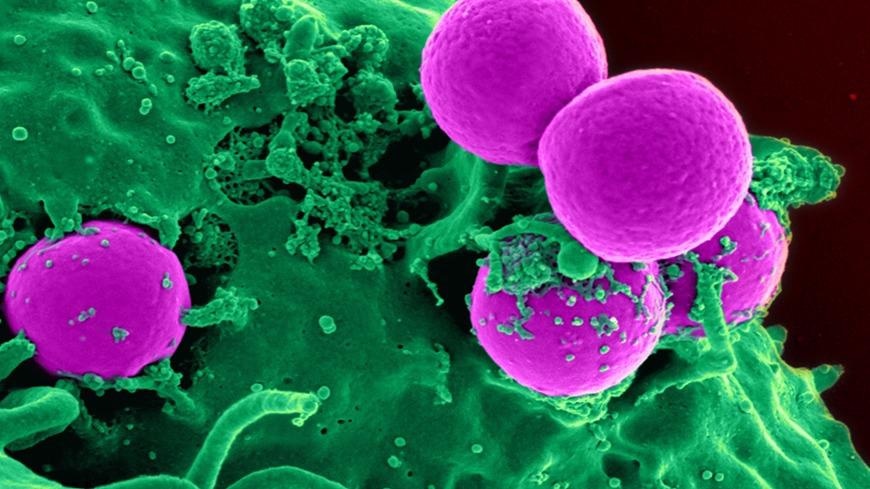Apr 23 2021
Bacteria are presently ahead of humans in the arms race 'mankind against bacteria.' Antibiotics—the previous miracle weapons of humans—are failing more often because tricky maneuvers are used by microorganisms to safeguard themselves from the impacts of these medications.
 Antibiotic-resistant bacteria are being swallowed by a human white blood cell. Colorized, scanning electron microscopic (SEM) image. Image Credit: CDC/NIAID.
Antibiotic-resistant bacteria are being swallowed by a human white blood cell. Colorized, scanning electron microscopic (SEM) image. Image Credit: CDC/NIAID.
A few species even retreat within the human cells in which they remain 'invisible' to the immune system. Such dangerous pathogens include multi-resistant staphylococci (MRSA) that can cause sepsis and pneumonia, which are life-threatening diseases.
To track down these pathogens in their hideouts and ultimately remove them, a research team from Empa and ETH Zurich is currently designing nanoparticles that use an entirely different mode of action from traditional antibiotics—while antibiotics find it difficult to enter human cells, these nanoparticles can easily enter the membrane of the affected cells because of their tiny size and structure.
Once they reach there, the nanoparticles can fight the germs.
Bioglass and Metal
Cerium oxide, a material with anti-inflammatory and antibacterial properties in its nanoparticle form, was used by the research team of Inge Herrmann and Tino Matter. The team integrated the nanoparticles using a bioactive ceramic material called bioglass.
Bioglass has attracted a great deal of interest in the medical field because of its versatile regenerative characteristics and is used, for instance, for rebuilding bones and soft tissues.
The researchers subsequently produced flame-made nanoparticle hybrids composed of bioglass and cerium oxide. Previously, the particles have been effectively used as wound adhesives in which many fascinating properties can be used at the same time—because of these nanoparticles, inflammation can be dampened, bleeding can be stopped, and wound healing can be expedited.
Besides this, the new particles demonstrate significant effectiveness against microorganisms and the treatment is also well tolerated by human cells.
The novel technology was successfully patented. The researchers have recently published their results in the scientific journal Nanoscale in the “Emerging Investigator Collection 2021.”
Tricky Germs
Among microorganisms, there are some specifically dreaded pathogens that enter the cells and are, hence, not visible to the immune system. This is how these pathogens survive whenever the body’s defense is on an alert mode.
A phenomenon like this is also recognized for staphylococci. These bacteria can retreat into bones, cells of the connective tissue and skin, and even the immune system. However, the persistence mechanism is yet to be fully understood.
Staphylococci are chiefly harmless microbes that can be detected on the mucous membranes and skin. But under specific conditions, the bacteria penetrate the body and cause serious inflammation, or even lead to sepsis and toxic shock. This renders staphylococci the leading cause of infection-related death with just one single type of pathogen.
The growing number of staphylococcal infections that no longer react to antibiotic treatment is specifically dangerous.
MRSA, which are multi-resistant germs, are specifically feared in hospital settings where, as nosocomial germs, they colonize catheters and other medical equipment or lead to poorly treatable wound infections. On the whole, about 75,000 hospital infections occur in Switzerland per year, of which 12,000 are fatal.
Destruction of Germs
Using electron microscopy, among other various techniques, the team was able to demonstrate the interactions between the human cells, the hybrid nanoparticles, and the pathogens.
If nanoparticles are used to treat the infected cells, the bacteria within the cells start to dissolve. But when the team specifically inhibited the uptake of the hybrid particles, this antibacterial effect was absent. Hence, the exact mode of action of the particles is yet to be completely understood.
It has been demonstrated that antimicrobial effects are also present in other metals.
But cerium is less harmful to human cells when compared to, for example, silver. Investigators now believe that the nanoparticles affect the bacterial cell membrane, producing reactive oxygen species that destroy the pathogens.
Since the human cell membrane is structurally different, this process does not affect the human cells.
According to the researchers, that resistance may not develop against this kind of mechanism.
What’s more, the cerium particles regenerate over time, so that the oxidative effect of the nanoparticles on the bacteria can start all over again.
Tino Matter, Researcher, Empa
In this manner, the cerium particles are likely to have a long-lasting impact.
The researchers now want to examine the interactions of the particles that occur in the infection process in more detail to further improve the composition and structure of the nanoparticles. The objective is to design a simple, powerful antibacterial agent that is effective within the infected cells.
Cerium: Jack-of-All-Trades Among the Chemical Elements
Cerium is a chemical element that was wrongly named after the dwarf planet Ceres. Today, this silvery metal is making a big splash. It is used as cerium oxide and is integrated into car catalytic converters. It is also used for producing diverse products, such as windscreens, self-cleaning ovens and light-emitting diodes (LEDs).
The anti-inflammatory and antimicrobial properties of this element also make it fascinating for medical use.
Journal Reference:
Matter, M. T., et al. (2021) Inorganic nanohybrids combat antibiotic-resistant bacteria hiding within human macrophages. Nanoscale. doi.org/10.1039/D0NR08285F.